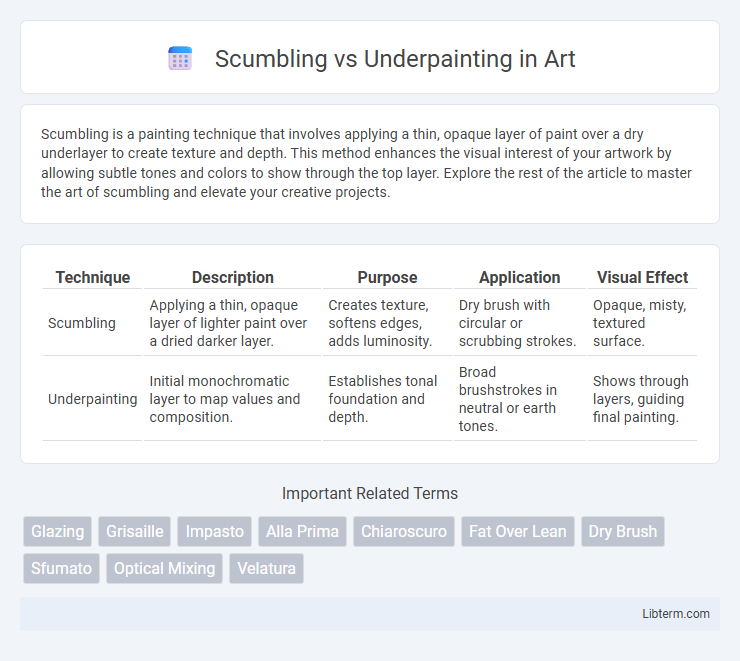Scumbling is a painting technique that involves applying a thin, opaque layer of paint over a dry underlayer to create texture and depth. This method enhances the visual interest of your artwork by allowing subtle tones and colors to show through the top layer. Explore the rest of the article to master the art of scumbling and elevate your creative projects.
Table of Comparison
| Technique | Description | Purpose | Application | Visual Effect |
|---|---|---|---|---|
| Scumbling | Applying a thin, opaque layer of lighter paint over a dried darker layer. | Creates texture, softens edges, adds luminosity. | Dry brush with circular or scrubbing strokes. | Opaque, misty, textured surface. |
| Underpainting | Initial monochromatic layer to map values and composition. | Establishes tonal foundation and depth. | Broad brushstrokes in neutral or earth tones. | Shows through layers, guiding final painting. |
Understanding Scumbling and Underpainting
Scumbling involves applying a thin layer of opaque or semi-opaque paint over a dry layer to create texture and soften colors, enhancing depth and luminosity. Underpainting serves as the foundational layer, using monochromatic tones to establish values and composition that guide subsequent color application. Mastery of both techniques allows artists to build complex visual effects and richer, more dynamic paintings.
Historical Origins of Scumbling and Underpainting
Scumbling originated in the Renaissance period as artists sought to create texture and atmospheric effects by applying thin, opaque layers of paint over dried layers, enhancing depth and tonal variation. Underpainting, dating back to the 15th century, was primarily used by Old Masters such as Leonardo da Vinci and Jan van Eyck to establish composition, tonal values, and support subsequent transparent glazes. Both techniques reflect evolving artistic ambitions during the Early and High Renaissance to achieve realism and intricate light effects in oil painting.
Key Techniques in Scumbling
Scumbling involves applying a thin, semi-opaque layer of paint over a dried layer to create texture and soften edges, enhancing depth and luminosity in a painting. Key techniques include using a dry brush with minimal paint, employing circular or scrubbing motions to achieve an uneven, broken color effect, and avoiding full coverage to allow underlying colors to subtly show through. This contrasts with underpainting, which lays a solid, tonal foundation to define composition and values before adding layers.
Essential Steps in Underpainting
Underpainting involves creating a monochromatic base layer to establish composition, value, and tonal relationships before applying color. Essential steps include sketching the basic outlines, blocking in major shapes with neutral tones, and refining shadows and highlights to build depth. This foundation guides subsequent color layers and enhances the overall painting's structure and luminosity.
Materials and Tools for Both Methods
Scumbling requires dry, stiff bristle brushes or fan brushes to apply thin, semi-opaque layers of paint over dried surfaces, often using oil or acrylic paints with minimal medium to achieve textured effects. Underpainting employs a range of brushes, including flat and filbert brushes, and typically uses fast-drying paints like burnt umber or raw sienna in oil or acrylic as a monochromatic base layer to establish tonal values. Palette knives, rags, and even sponges can support both methods by manipulating texture and paint distribution for varied visual depth.
Visual Effects: Scumbling vs Underpainting
Scumbling creates a soft, textured haze by applying a thin, opaque layer of paint that partially reveals the underlying colors, enhancing depth and atmosphere in a painting. Underpainting establishes tonal values and composition through a monochromatic base layer, providing a foundation that influences the overall color richness and contrast. The visual effects of scumbling emphasize subtle light and texture variations, while underpainting contributes to structural clarity and color harmony.
When to Use Scumbling or Underpainting
Use scumbling to create soft, textured layers when you want to add depth and subtle color variations without fully covering the base layer. Underpainting works best for establishing tonal values and composition early in the painting process, providing a solid foundation for subsequent layers. Choose scumbling for highlights and atmospheric effects, whereas underpainting is ideal for building structure and guiding the overall painting.
Common Mistakes and How to Avoid Them
Scumbling often suffers from excessive paint thickness, leading to a loss of the intended soft texture; to avoid this, use a dry brush with minimal paint and apply light, feathery strokes. Underpainting mistakes typically include using overly dark or thick layers, which can obscure subsequent paint layers and disrupt color harmony; applying a thin, translucent wash helps maintain luminosity and provides a solid foundation. Both techniques require patience and control to build depth without overpowering subsequent layers, preserving the vibrancy and subtlety of the final artwork.
Famous Artists Who Used Scumbling or Underpainting
Famous artists like Rembrandt and Diego Velazquez skillfully employed underpainting techniques to establish tonal foundations and enhance depth in their portraits. In contrast, J.M.W. Turner and John Constable famously utilized scumbling to create atmospheric effects and subtle texture variations in their landscapes. These masterful applications of underpainting and scumbling demonstrate how foundational layering techniques contribute to the richness and realism of classical and romantic paintings.
Choosing the Right Technique for Your Artwork
Choosing between scumbling and underpainting depends on the desired texture and depth of your artwork; scumbling creates a soft, broken color effect by layering opaque or semi-opaque paint over dry layers, enhancing luminosity and atmospheric quality. Underpainting establishes the tonal foundation and composition with a monochromatic base, allowing for controlled value transitions and structural accuracy throughout the painting process. Artists often select scumbling for impressionistic or textured finishes, while underpainting is preferred for detailed realism and precise tonal development.
Scumbling Infographic

 libterm.com
libterm.com